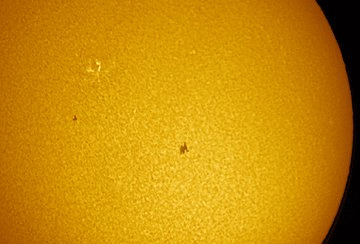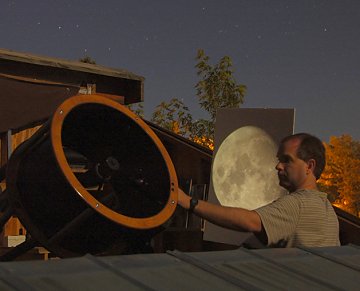| AURORA ALERTS: Did you miss the Northern Lights of June 14th? Next time get a wake-up call from Space Weather PHONE. | | | SUNGRAZING COMET--NOW! Today, the Solar and Heliospheric Observatory (SOHO) is monitoring a comet as it makes a seemingly perilous approach to the sun. Will it survive? Join SOHO for a ringside seat. SPACESHIP CROSSING: With solar activity at low ebb, the sun is nearly blank--no sunspots. That makes it easy to pick out the spaceships. On June 13th, John Stetson and students (E. Signorelli and C. Ryder) photographed space shuttle Discovery and the ISS transiting the sun: 
"The silhouette of the shuttle was clearly defined," says Stetson. "The much larger ISS was ironically fainter and had to be enhanced a bit during photo processing. We observed the double transit from Ocean Park, Maine." Less than a day after the transit, Discovery landed in Florida, capping a two-week mission to the ISS. The shuttle delivered a new bus-sized science lab named Kibo, Japanese for Hope. Installation of the lab, a joint ordeal of astronauts and the station's muscular robotic arm, was a success. So while the number of sunspots has dropped from two (shuttle+ISS) to one (ISS), the one is much bigger than before. NASA's next shuttle flight is slated for October when the crew of STS-125 is to service the Hubble Space Telescope. Stay tuned for flybys! LUNAR PROJECTION: Backyard astronomer Dan Bush of Albany, Missouri has found a new way to show off the Moon. "Last Saturday, June 14th, I projected an image of the Moon from the eyepiece of my 20-inch Dobsonian onto a white piece of cardboard," he explains. The result was quite pleasing: 
Photo details: Nikon D70, Nikkor 18-200mm, 25s, f/4.2 at 32.0mm, ISO 400
"The moon image is reversed since it is a reflection," he says. "You can see many craters including Sinus Iridum (the Bay of Rainbows) at the top." Readers, the Moon will be full this Wednesday night. Grab your telescope and a piece of cardboard and head for the nearest sidewalk. Passersby will enjoy the show. NLC ALERT: Noctilucent cloud season is underway. In the past week, sky watchers have spotted glow-in-the-dark electric blue tendrils over England, Canada, Ireland, Northern Ireland and the Netherlands. Check the photo gallery for observing tips and be alert for NLCs.
May 2008 Aurora Gallery
[Aurora Alerts] [Night-sky Cameras] | 
